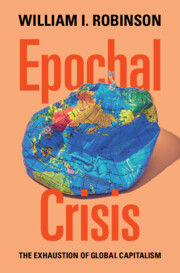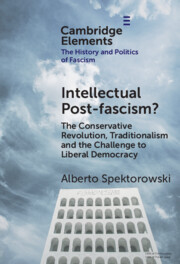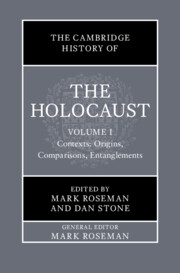Refine search
Actions for selected content:
226 results
‘Voi e il cinema’. Visual culture, gender and cinema consumption in Fascist Italy (1938–43)
-
- Journal:
- Modern Italy , First View
- Published online by Cambridge University Press:
- 12 September 2025, pp. 1-24
-
- Article
-
- You have access
- Open access
- HTML
- Export citation
The role of the Banca Nazionale del Lavoro (BNL) in Fascist Italy’s economic strategy towards Franco’s Spain, 1936–43
-
- Journal:
- Modern Italy , First View
- Published online by Cambridge University Press:
- 12 September 2025, pp. 1-20
-
- Article
-
- You have access
- Open access
- HTML
- Export citation

Epochal Crisis
- The Exhaustion of Global Capitalism
-
- Published online:
- 21 August 2025
- Print publication:
- 04 September 2025
Chapter 5 - Hoodoo Conversions
-
- Book:
- Manufacturing Dissent
- Published online:
- 03 October 2025
- Print publication:
- 21 August 2025, pp 166-210
-
- Chapter
- Export citation
Introduction
-
- Book:
- Manufacturing Dissent
- Published online:
- 03 October 2025
- Print publication:
- 21 August 2025, pp 1-15
-
- Chapter
- Export citation
8 - Locking into Liberalism
- from Part II - The KCIR in the World
-
- Book:
- The Kansas Court of Industrial Relations
- Published online:
- 26 July 2025
- Print publication:
- 14 August 2025, pp 197-217
-
- Chapter
- Export citation
Between Art and Craft: Operatic Set Design in 1930s Florence
-
- Journal:
- Cambridge Opera Journal , First View
- Published online by Cambridge University Press:
- 07 August 2025, pp. 1-21
-
- Article
-
- You have access
- Open access
- HTML
- Export citation
Turning points and transformations in contemporary Italy: a century of big changes through ‘small histories’
-
- Journal:
- Modern Italy / Volume 30 / Issue 3 / August 2025
- Published online by Cambridge University Press:
- 07 August 2025, pp. 267-275
- Print publication:
- August 2025
-
- Article
-
- You have access
- HTML
- Export citation
Chapter 39 - Post-colonialism
- from Part VI - Critical Understandings
-
-
- Book:
- Sean O'Casey in Context
- Published online:
- 23 June 2025
- Print publication:
- 10 July 2025, pp 423-434
-
- Chapter
- Export citation
2 - Into the Dark
-
- Book:
- Warriors in Washington
- Published online:
- 23 June 2025
- Print publication:
- 10 July 2025, pp 34-60
-
- Chapter
- Export citation
Chapter 9 - Dictatorship, Occupation and Internment
-
- Book:
- Emigrant Soldiers
- Published online:
- 05 June 2025
- Print publication:
- 26 June 2025, pp 185-222
-
- Chapter
- Export citation

Intellectual Post-fascism?
- The Conservative Revolution, Traditionalism and the Challenge to Liberal Democracy
-
- Published online:
- 23 June 2025
- Print publication:
- 10 July 2025
-
- Element
- Export citation
5 - Fascism and Holocaust
-
-
- Book:
- The Cambridge History of the Holocaust
- Published online:
- 16 May 2025
- Print publication:
- 12 June 2025, pp 93-112
-
- Chapter
- Export citation
3 - From “Final Solution” to “Holocaust”: Autobiographical Reflections
-
-
- Book:
- The Cambridge History of the Holocaust
- Published online:
- 16 May 2025
- Print publication:
- 12 June 2025, pp 62-73
-
- Chapter
- Export citation
13 - Communism and Anticommunism
-
-
- Book:
- The Cambridge History of the Holocaust
- Published online:
- 16 May 2025
- Print publication:
- 12 June 2025, pp 268-287
-
- Chapter
- Export citation

Emigrant Soldiers
- Mobilising Italians Abroad in the First World War
-
- Published online:
- 05 June 2025
- Print publication:
- 26 June 2025
Where Europe ends, where Africa begins: Transimperial dryland science in the Italian south (1900s–40s)
-
- Journal:
- Journal of Global History , First View
- Published online by Cambridge University Press:
- 27 May 2025, pp. 1-22
-
- Article
-
- You have access
- Open access
- HTML
- Export citation

The Cambridge History of the Holocaust
-
- Published online:
- 16 May 2025
- Print publication:
- 12 June 2025
The Italian Resistance: historical junctures and new perspectives
-
- Journal:
- Modern Italy / Volume 30 / Issue 2 / May 2025
- Published online by Cambridge University Press:
- 08 May 2025, pp. 125-130
- Print publication:
- May 2025
-
- Article
-
- You have access
- Open access
- HTML
- Export citation
34 - Corporatism
- from Part III. A - The State
-
-
- Book:
- The Cambridge Handbook of Constitutional Theory
- Published online:
- 27 March 2025
- Print publication:
- 24 April 2025, pp 585-602
-
- Chapter
- Export citation
